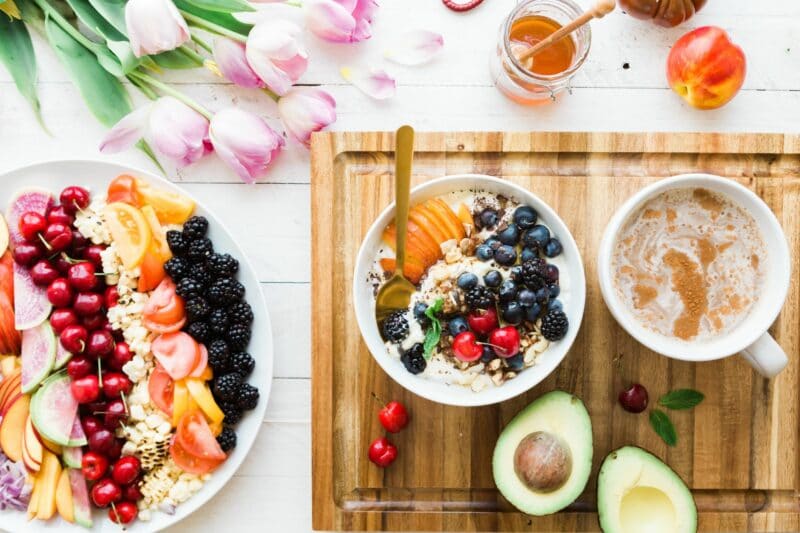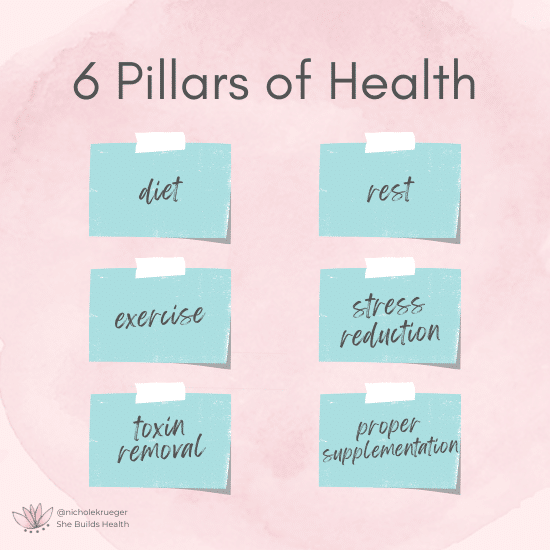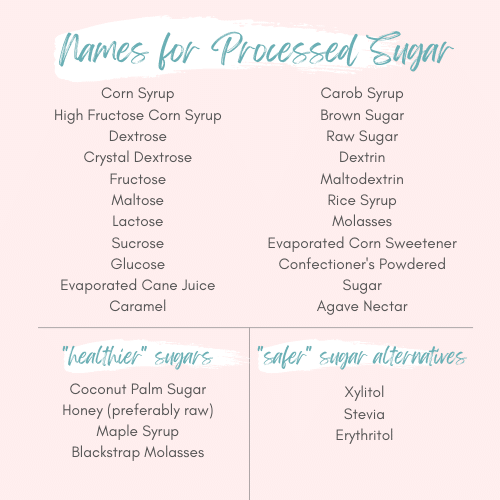The Pillars of Health and a Deep-Dive into Diet
By Nichole Krueger | April 26, 2022

6 Pillars of Health
Do you get overwhelmed with all of the information available on health? Then to make matters worse, so much of that information contradicts each other…what’s a girl to do?
Getting healthy can feel hard, especially if you have symptoms and diagnoses to contend with. But being healthy doesn’t have to be complicated. It takes commitment and work, but you can TOTALLY achieve your goals. Oftentimes our goals are met simply by following six pillars of health.
I know what you’re thinking, “Yeah, yeah, I’ve heard this before”, but try to read with fresh eyes and a beginner’s mind. See if there’s anything new you can learn and gradually start applying to your daily life. This is how habits are made!
We’ll address each of these 6 areas over the next several weeks. If you begin to implement what you learn, you will start to build (or re-build) your health!

These pillars of health help people lose weight, reverse symptoms of anxiety and depression, brain fog, focus issues. They can reverse insulin resistance, heart disease, type II diabetes, infertility & other hormone imbalances. They help in controlling the progression of (or put into remission) many forms of autoimmunity. We have a LOT more control over our health that we realize!
Let’s dive into Pillar #1: Diet
Y’all, we need to start here. The food that you put into your body is THE #1 contributor to the state of your health. It may be a coincidence that the acronym for the Standard American Diet is SAD, but “sad” is an accurate description. (Watch for an upcoming post about how our diets got to be so sad, but for now let’s just say we need to ditch the Food Pyramid and My Plate.)
If this is where you are, don’t beat yourself up. We were all been taught by well-meaning curriculums, dieticians, and our doctors that this is how we should eat (because that’s what THEY’VE were taught). But you don’t have to look far to see chronic illness – what we’re doing obviously isn’t working.
4 Diet Changes that have BIG Impact
If you begin to incorporate these 4 diet changes into your daily lifestyle (one step at a time), you’ll see notable differences in your mood, your energy, how you sleep, your level of pain and inflammation – it’s so impactful!
1) Go Gluten Free
If you’ve been around me for a minute, you know how I feel about gluten. And the literature backs it up – gluten sensitivity is FAR more prevalent than we know. And of those who are gluten sensitive, 80% of them aren’t affected with digestive symptoms – it affects their mind and their mood. The literature on this dates back to the 1970s (1).
As a matter of fact, many studies have shown that gluten sensitivity is associated with major psychiatric disorders (2). Gluten is also known to cause leaky gut (3). Gliadin, the protein found in gluten, triggers the body to release a compound called zonulin. Zonulin causes the tight junctions in the lining of the intestines to temporarily open up. This is problematic because when these junctions open, it exposes our immune system to the contents of our intestines and allows bacteria, LPS & other toxins, and large food particles into our body. This triggers inflammation, food allergies & sensitivities, immune system abnormalities, and autoimmunity. This also impacts the blood-brain barrier and can cause neuroinflammation.
If you need some help getting started, check out my gluten free snack list and my gluten-free recipe guide (click the “Get the eBook” button on my homepage).
2) Ditch the Dairy (if you’re having any health issues concerns)
There are several reasons dairy can be a problem, and it seems to be especially problematic in populations that have existing health concerns.
Culprit #1: Lactose Intolerance. Lactose is a naturally occurring sugar found in milk. Experts estimate that about 68 percent of the world’s population has lactose malabsorption (which can lead to lactose intolerance)(4). According to Mark’s Daily Apple, this happens when people stop making lactase, the enzyme that breaks lactose down for easy digestion. Lactase production usually slows down or stops around the 4th or 5th year of life. Symptoms of lactose intolerance are stomach upset, bloating, diarrhea, nausea, gas, and a host of other uncomfortable digestive symptoms.
Culprit #2: Diary Protein Intolerance. Dairy has two proteins: whey and casein. When people have a dairy allergy, this is what they are reacting to – one of the proteins (most commonly, casein). In an intolerance, symptoms can be a bit more chronic, and its effects can be felt nearly anywhere. Diarrhea, constipation, joint pain, headaches, nasal drainage, throat clearing. It can trigger psoriasis, eczema, or Reynaud’s flare. It can give you a foggy head or make you break out with acne.
Another big issue with dairy is the use of antibiotics. On conventional dairy farms (which is where the majority of the milk in your local grocery store is obtained), the cows live in crowded, unfavorable conditions and end up with infections such as mastitis. Because of this, it is common practice to include antibiotics in their feed. This ends up in the milk, which ends up in your body, which contributes to antibiotic resistance, reduced microbial population in your GI tract, and damaged gut health. (Organic dairy farmers do not follow these practices, so if you’re going to have dairy, make sure it’s organic!)
Looking for some ideas for dairy free meals? My gluten-free recipe guide is also dairy-free! Click here to get the guide.
3 – Cut Out Refined Sugar and Artificial Sweeteners
Refined Sugar is INVASIVE, and it goes by many names (save the image for future reference!) It’s in mayonnaise, salad dressings, cereals, bread, chicken nuggets, crackers, chips – pretty much anything in a box, bag, or bottle. And if it says “sugar free”, RUN! That’s where you’ll find artificial sweeteners, which are often worse for you than the real thing.

Refined sugars are linked to conditions like obesity, type 2 diabetes, high blood pressure, heart disease, depression, dementia, liver disease, and certain types of cancer. (5, 6, 7, 8, 9, 10, 11)
The worst kind of refined sugar is High Fructose Corn Syrup (HFCS). HFCS is made from genetically modified (GMO) corn that has been HIGHLY processed. According to Dr. Josh Axe, the dangers of HFCS include weight gain, cancer, fatty liver and liver stress, increased cholesterol levels, diabetes, high blood pressure, heart disease, leaky gut, and increased mercury intake.
Artificial sweeteners would be more accurately called chemical sweeteners. They negatively impact your body by killing off the good bacteria in your gut (12), giving the bad microbes unchecked domain in your intestines – which can lead to leaky gut, which can lead to a list of health issues too numerous to list here.
For years the sugar industry has lobbied to vilify fat, when in fact sugar is what is making us fat (via insulin). But there ARE some forms of fat that fall into the villain category…
4) Eliminate Vegetable Oils
These oils are toxic to our body because of the way they plants are grown (canola, soy, corn, and cottonseed oils are genetically modified), the way they are processed (using hexane and other solvents), and because they cause oxidative stress in our bodies. Excessive oxidation equals inflammation, damage to cellular structures, and damage to DNA. Not only are they GMO and covered in solvents, but when these oils are heated, they turn into trans fats that wreak havoc inside our gut, liver, brain and blood vessels.
What oils should you be using? Olive oil, avocado oil, coconut oil, and ghee* are great health-building oils that have nutritional benefits. Note that if you heat your olive oil, do not heat to high temps. For high temperature cooking, such as roasting or pan-frying, use avocado oil, coconut oil, or ghee.
*Ghee is technically dairy, but it is clarified, meaning all of the milk solids have been removed. Unless you have a true dairy allergy, ghee is a good choice for fat in your diet.
So now what do I eat?
If you find yourself flipping over packages of food to look at the ingredient label and you have a hard time finding food without these ingredients, don’t be surprised. That’s one of the reasons our country is so sick – this is what’s in the packaged food.
There are some higher quality packaged foods without these ingredients – but you really have to look for it. Check your online health food grocers like Thrive Market for some better options (use the Thrive Market link for a special discount!) Stick to outer edge of the grocery store where the whole foods like meat, eggs, fruit, and veggies are kept. Or the bulk bins at the health food store containing whole grains like rice, oats, and quinoa. Then make your meals from scratch! Throw steak or chicken thighs on the grill, make a salad (with a clean dressing).
If the temptation is to “go all in” and eliminate everything mentioned above, let me caution you. It takes time to make lifestyle changes, especially when it comes to our food. Pick one of the items from the list, and work on that first. Once you have that nailed, move on to the next. The goal is to make this a new lifestyle – so you aren’t in a hurry!
References
[1] Nutrition and Your Mind by Dr. George Watson
[4] Storhaug CL, Fosse SK, Fadnes LT. Country, regional, and global estimates for lactose malabsorption in adults: a systematic review and meta-analysis. The Lancet. Gastroenterology & Hepatology. 2017;2(10):738–746.


